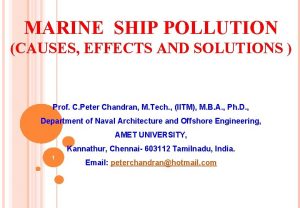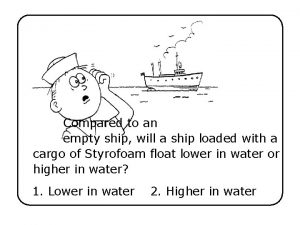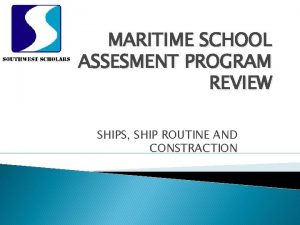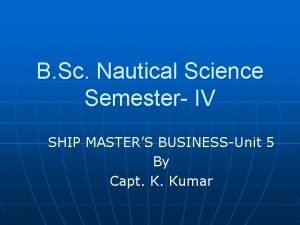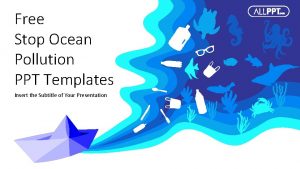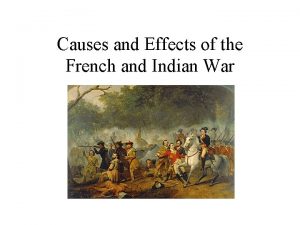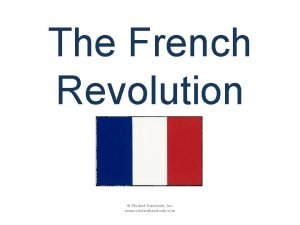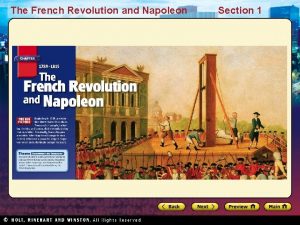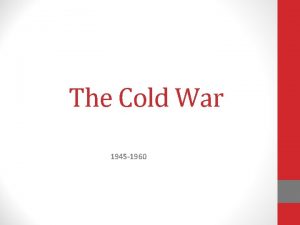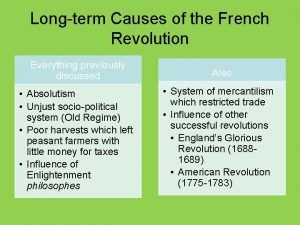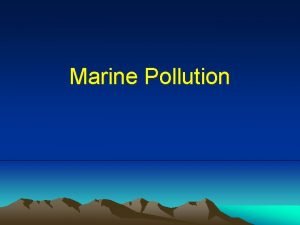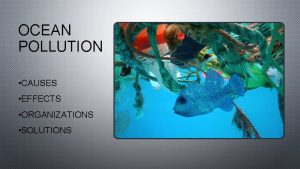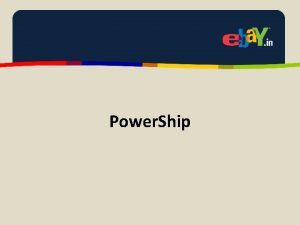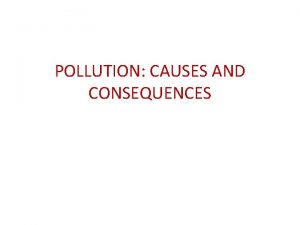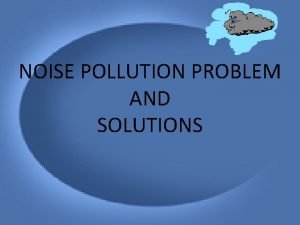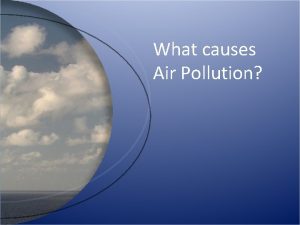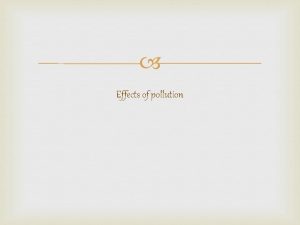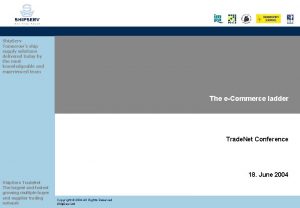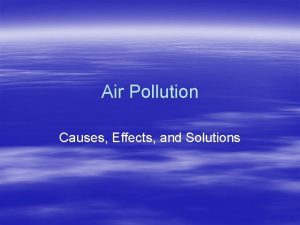MARINE SHIP POLLUTION CAUSES EFFECTS AND SOLUTIONS Prof
















- Slides: 16

MARINE SHIP POLLUTION (CAUSES, EFFECTS AND SOLUTIONS ) Prof. C. Peter Chandran, M. Tech. , (IITM), M. B. A. , Ph. D. , Department of Naval Architecture and Offshore Engineering, AMET UNIVERSITY, Kannathur, Chennai- 603112 Tamilnadu, India. 1 Email: peterchandran@hotmail. com

CONTENTS v Introduction v Eight ways in which cruise ships can cause Marine Pollution v Effects of Marine Ship Pollution v Monitoring, Control and preventing measures of Marine Pollution v Oily Water Seperator v Ballast Water Management v Ships Waste Water Treatment v Conclusion and Recommendation 2

INTRODUCTION v A Cruise Ship is a large ship that carries people on voyages for pleasure, typically calling in at several places. v Marine ship pollution refers to the contamination or presence of pollutants in oceans. v Do ships pollute the water? ships can dump the sewage straight into international waters- polluting the pristine ocean near cruise destination hot spots. A cruise ship pollute as much as 13 Million cars – in one day. The extent and the ways in which Cruise pollution is caused can be explained in depth in the following eight ways: 1. Ballast water pollution 2. Air Pollution 3. Noise Pollution 4. Grey water Pollution 5. Black water/ sewage pollution 6. Chemical Pollution 7. Solid waste Pollution 3 8. Oil Pollution/ Bilge oil pollution

BALLAST WATER POLLUTION The letting of the ballast water from the ships is a major cause of cruise pollution. The ballast water that is disposed off may contain a variety of harmful substances, including in certain cases oil contaminants, nonnative marine animals and plants, and disease causing organisms in sewage contaminated water. (Definition of Ballast water: 4

AIR POLLUTION v We are all aware of the concept of Air Pollution. v The engine of the cruise ships also emit unwanted air. The cruise ships emissions the gases on the sea, leading to ship pollution of immense proportions in the oceanic area 5 Air Pollution by Luxury Cruise Ship

NOISE POLLUTION v Cruise Ships are known for their entertainment value. But even as the entertainment goes on in the cruise ships, noise pollutions from the ships machinery and other activities affects the marine animals and mammals whose sensitive hearing gets harmed and debilitated, often leading to their unwanted death and an overall loss to the eco-system. 6 Noise Pollution by Cruise Ships

GREY WATER POLLUTION v Regular activities like cleaning utensils and doing the laundry causes cruise ship pollution. v The grey water accumulation contains not just harmful chemicals but sometimes even metals and minerals too. v Grey water concentration in the ocean waters harms the marine environment. 7 Grey Water Pollution by Ship

BLACK WATER / SEWAGE POLLUTION v v The next huge cruise pollution is from sewage. v Sewage includes waste from the toilets and the health facilities provided in the cruise ships. Classified as black water, around 30, 000 gallons of sewage is deposited into the ocean by cruise ships. CHEMICAL POLLUTION v Materials like batteries, chemicals past their expiry and processing of pictures in a cruise ship also leads to marine pollution. v The materials are hazardous and posses a huge threat to the lives of the marine creatures and life forms. v These materials enter into the oceanic waters through either the grey water or the black water channels. 8 Chemical Pollution by Cruise Ship

SOLID WASTE POLLUTION v Materials like paper, cardboard and aluminium can also turn out to be a cause of cruise ship pollution in the marine areas. v They are categorized as solid waste and they end up forming an unwanted debris on the oceanic surface leading to large scale threats for the oceanic plants and creatures OIL POLLUTION / BILGE OIL POLLUTION v Last but not the least- oil/bilge pollution. Oil Pollution is the main reason for the increased level of marine Pollution. Oil leaks through faulty engine system and improper repair work and mix with the oceanic water. v Oil is heavier than water. It does not degrade quickly leading to problems to marine creatures and plants. Marine creatures and plants are forced to ingest such polluted water. It is necessary to preserve Eco-system. 9 Oil Spills and Ship Groundings

EFFECTS OF MARINE SHIP POLLUTION The following are the effects of Marine Ship Pollution: 1. Oxygen depletion 2. Higher acidity 3. Choking Marine life, 4. Spoiling bird’s feathers 5. Blocking the sunlight 6. Dangers to Human Health SOLUTIONS 1. Be careful with our chemicals 2. Don’t flush or rinse away harmful particles 3. Campaign 4. Volunteer at an oil spill site 5. Volunteer at a beach cleanup- or organize one yourself 6. Ensuring no debris is released into ocean. 10

MARPOL 73/78 CONVENTION v MARPOL is short for Marine Pollution and 73/78 short for years 1973 and 1978. It is one of the most important International Marine Environmental Conventions. v It was developed by the International Maritime Organization(IMO) in an effort to minimize pollution of the oceans and seas, including dumping oil and air pollution. v The objective of this convention is to preserve the Marine Environment in an attempt to completely eliminate pollution by oil and other harmful substances and to minimize accidental spillage of such substances Annex Title Entry into Force Annex I Prevention of pollution by oil & oily water 2 october 1983 Annex II Control of Pollution by noxious liquid substances in bulk 6 April 1987 Annex III Prevention of Pollution by harmful substances carried by sea in packaged form 1 July 1992 Annex IV Pollution by sewage from ships 27 September 2003 Annex V Pollution by garbage from ships 31 December 1988 Annex VI Prevention of Air. Pollution from Ships 19 May 2005 Marpol Annex I-VI 11

PROVISIONS v MARPOL 3 is divided into Annexes according to various categories of pollutants, each of which deals with the regulation of a particular group of ship emissions. v Annex I: It deals with discharge of oil into the ocean environment. It incorporates the discharge criteria. The regulation requires that oil content in the ocean water outlet does not exceed the limit of 15 parts per million. v Annex II ; It deals with the discharge criteria for the elimination of pollution by noxious liquid substances carried in large quantities, Chemicals including, acids alcohols, caster oil, hydrogen peroxide, pentanol sodium sulphate, etc. , v Annex III: It contains general requirements for the standards on packing, labeling, documentation, stowage, quantity subtraction, division and notifications for preventing polluting by harmful substances. v v Annex IV; It introduces requirements to control pollution of the sea by sewage from ships. v Annex VI: It introduces requirements to regulate the air pollution being emitted by ships, including the emission of ozone depleting substances, Nitrogen oxides ( No. X), Sulpher Oxides (SOX), Volatile Organic Compounds (VOC) and Shipboard incineration. Annex V: Regulations for prevention of Pollution by Garbage from ships. It specifies the distances from land in which materials may be disposed of and subdivides different types of garbage and marine debris. The important part is the complete ban of dumping plastic into the ocean. 12

OILY WATER SEPARATOR v Annex I of the Convention made it mandatory that oil tankers and any ship of 400 gross tonnages and above must be fitted with an oily- water equipment or filtering system. v Annex I made it mandatory for new oil tankers to have double Hull. v An Oily Water Separator (OWS) (marine) is a piece of equipment specific to the shipping or marine industry. It is used to separate oil and water mixtures into their separate components. 13 Oily Water Separator

BALLAST WATER MANAGEMENT v In order to reduce the harmful effects on the marine environement through ballasting operations of the ship, the IMO adopted a Convention to control and manage ships ballast and sediment on 13 February 2004. v It requires all commercial ships to install and operate ballast water treatment system (BWTS ) Merits v Operational delays can be avoided which will save time and money. v Reporting for requirements of different post state authority is simplified v Safe ballast exchange can be carried out anywhere in the world. 14 Ballast Water Management

SHIPS WASTE WATER TREATMENT v The major aim of waste water treatment is to remove as much of the suspended solids as possible before the remaining water, called effluent, is discharged back to the environment. v Waste water produced on board ships is required to be treated to acceptable level before being discharged overboard to prevent pollution of the sea. v The discharge of sewage into the sea is prohibited except when the ship has in operation an approved sewage treatment plant. 15 Biological Sewage Treatment Plant

CONCLUSION v Sources of Marine Pollution from ships have been established, which includes discharge of oilywater, invasive organisms from ballast, Grey water and black water pollution, air, noise and solid waste pollution. v v Pollutants damages the ecosystem. Systems life and human health. Control and Preventive measures have been established including adhearance and enforcement of standard operations as contained in Annex I- VI of IMO Conventions. RECOMMENDATIONS v v Control marine pollutions by introducing penalities to ships found polluting the Marine Environment. Exchange technical information, technology, experience between countries all over the world. Protect aquatic environment and practice IMO Standards. Cleanup the marine environment and create awareness by educating Citizen and Ship owners, respect and protect Marine Environment. THANK YOU 16 Most Luxurious Cruise Ship
 Pollution causes effects and solutions
Pollution causes effects and solutions Marine noise pollution
Marine noise pollution Compared to an empty ship would a ship loaded
Compared to an empty ship would a ship loaded Flounder plate ship
Flounder plate ship Marpol annex 1 to 6
Marpol annex 1 to 6 Marine pollution ppt template
Marine pollution ppt template Causes and effects of the french and indian war
Causes and effects of the french and indian war Causes and effects of the russian revolution
Causes and effects of the russian revolution Causes and effects of french revolution
Causes and effects of french revolution Short term causes of the french revolution
Short term causes of the french revolution Causes and effects of french revolution
Causes and effects of french revolution Summary on the cold war
Summary on the cold war American revolution strengths and weaknesses
American revolution strengths and weaknesses French revolution causes and effects
French revolution causes and effects French revolution causes and effects
French revolution causes and effects American revolution causes and effects
American revolution causes and effects French revolution
French revolution

